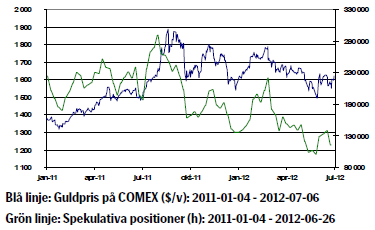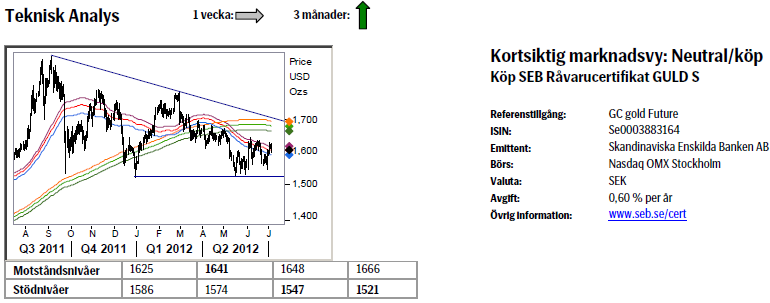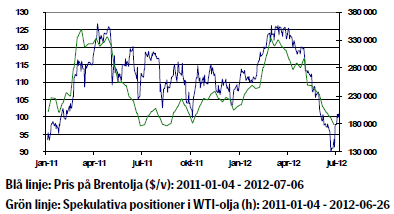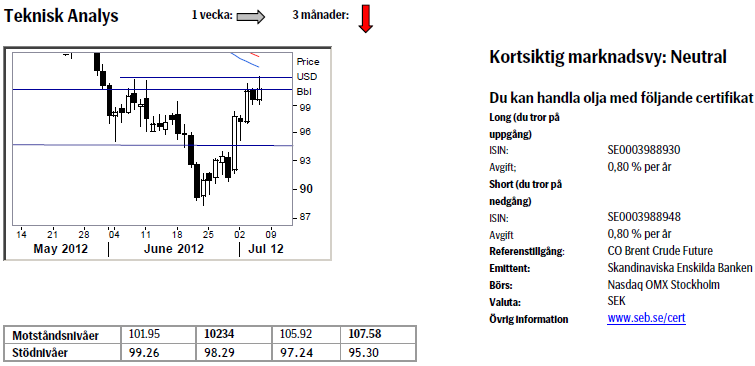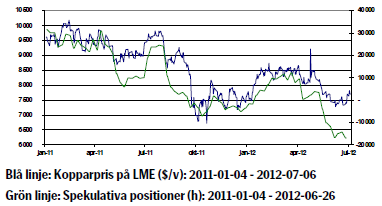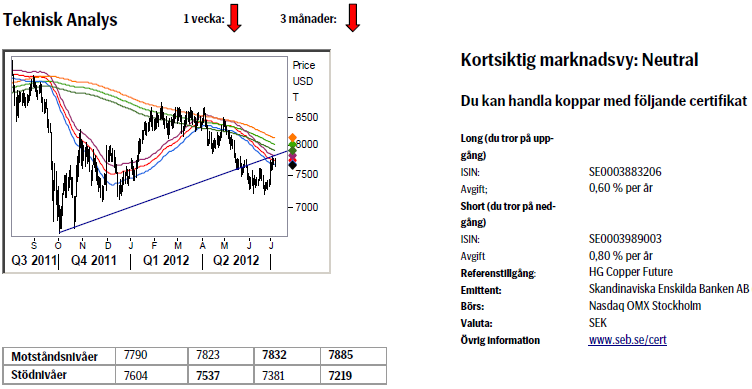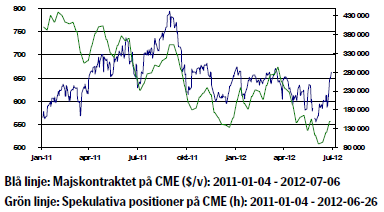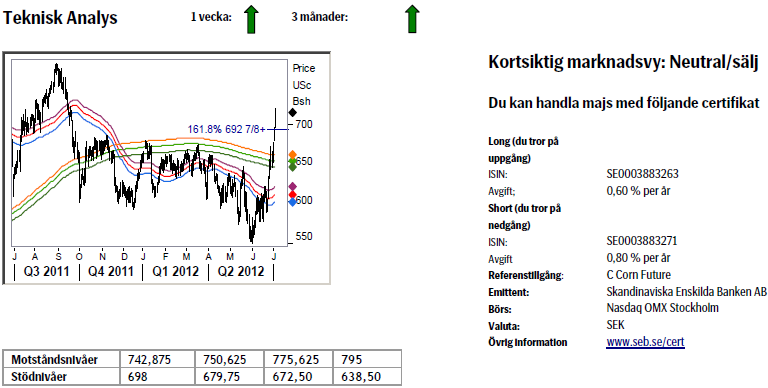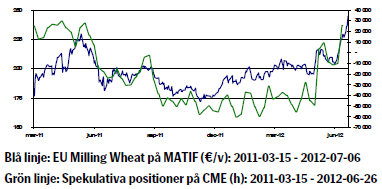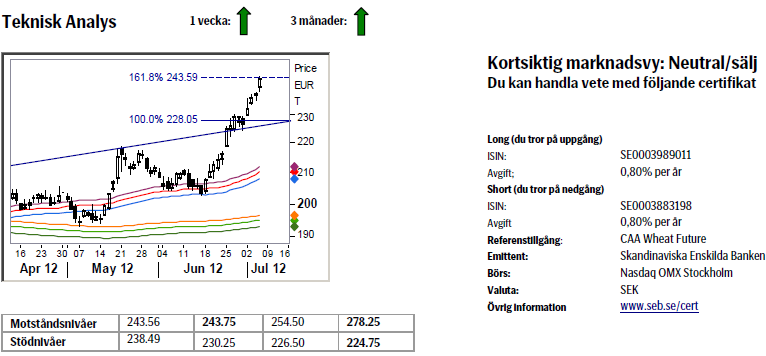Analys
SEB – Råvarukommentarer vecka 27 2012
Sammanfattning: Denna vecka
- Brett råvaruindex: +2,31%
UBS Bloomberg CMCI TR Index - Energi: +1,65%
UBS Bloomberg CMCI Energy TR Index - Ädelmetaller: -0,33%
UBS Bloomberg CMCI Precious Metals TR Index - Industrimetaller: +0,04%
UBS Bloomberg CMCI Industrial Metals TR Index - Jordbruk: +6,0%
UBS Bloomberg CMCI Agriculture TR Index
Kortsiktig marknadsvy:
- Guld: Neutral/köp
- Olja: Neutral
- Koppar: Neutral
- Majs: Neutral/sälj
- Vete: Neutral/sälj
Guld
Guldet reagerade positivt efter förra fredagens EU- toppmöte men fokus vändes sedan mot gårdagens räntebesked från europeiska centralbanken (ECB) där förväntningarna om ytterligare lättnader var höga. ECB sänkte igår sin viktigaste styrränta med 25 räntepunkter. Trots räntesänkningen blev investerarna besvikna när ECB-chefen Draghi sade att ECB inte är redo för ytterligare kvantitativa lättnader. Euron var den stora förloraren efter beskedet, dollarn stärkes och guldet tappade något.
Marknadens fokus idag är amerikanska “ Non farm Pay-rolls”. Förväntat är +100 000 nya arbetstillfällen vilket emellertid är en fortsatt svag siffra.
Samtidigt ökar fokus på kommande måndags eurogruppmöte som ska mejsla ut detaljer kring nödlånen till Spanien och Cypern samt bereda väg för krismekanismen ESM. Det är uppåtpress i italienska och spanska räntor, den 10-åriga spanska räntan uppgick igår till oroväckande 6,7 procent, och igår inledde Greklands premiärminister diskussioner med ”trojkan” om villkoren i låneuppgörelsen. IMF-chefen Lagarde har uttalat att hon ”inte alls är på humör att förhandla eller omförhandla” med Grekland. Situationen ser inte ljus ut och en betalningsinställelse kan inte uteslutas.
På kortsikt är vi fortsatt positiva till guldet som finner stöd i den europeiska skuldkrisen.
Teknisk analys: Slagigt runt 55dagars bandet.
Ena veckan under, nästa vecka över 55dagars bandet, det är inte lätt att hitta något pålitligt kortsiktigt mönster i denna röra varför vi anser att det bästa man kan göra är att antingen bara sitta långsiktigt lång och vänta ut nuvarande situation eller helt enkelt handla något annat tills bilden klarnar.
Olja
Pensionskonflikten inom den norska oljeindustrin fortsätter. Arbetsgivarna beslöt att införa lockout för att bryta dödläget i förhandlingarna med facket. Produktionsförlusterna har uppgått till cirka 240 000 fat olja per dag. Produktionsstoppet har pressat upp priserna för Brentoljan men analytiker förväntar sig att norska myndigheter kommer att medla och kanske avbryta lockouten.
I Teheran diskuteras i parlamentet ett lagförslag som skulle göra det möjligt att stoppa tankfartyg i Hormuzsundet tillhörande länder som stöder sanktionerna mot landet. Hur lagen skulle utformas och framförallt tillämpas är inte känt dessutom vet vi i nuläget inte heller hur presidenten eller det militära respektive religiösa styrande toppskiktet ställer sig till förslaget. Skulle de göra allvar av saken kan man nog räkna med motreaktioner från omvärlden. USA har skickat ytterligare minsvepare till området.
Sammantaget har marknaden tagit fasta på utbudsstörningarna ovan samt förhoppningar om nya makroekonomiska stimulanser och Brentoljan steg med 2,3 procent under veckan.
Tisdagens API siffror visade att råoljelagren föll med tre miljoner fat vilket kan härledas från stormen i Mexikanska golfen som tvingat fram produktionsstopp. P.g.a. gårdagen Nationaldag i USA publicerade DOE siffror igår istället för onsdagen. Siffrorna visade att råoljelager föll med 4,2 miljoner fat.
Teknisk analys: Kraftfull rekyl upp till motstånd
Säljarna fick i fredags kasta sig på köpknappen och stoppa ut de senaste korta positionerna givet uppsvinget i risk aptit som följde på EU toppmötet. Denna rekyl bör nu befinna sig i sin slutfas och en vändning söderut är primärt att vänta i innevarande område.
Koppar
Igår sänkte Kinas centralbank (PBOC) styrräntorna, ettåriga in- och utlåningsräntor med 25 respektive 31 punkter, till 3,0 respektive 6,0 procent. Det var andra gången på en månad som Kina sänkte styrräntorna och gårdagens räntesänkning kom som en överraskning. Räntesänkningen är en signal att landets ekonomiska situation inte ser helt ljus ut och denna signal gjorde att kopparn inte steg på räntebeskedet. Myndigheter kommer ha fortsatt restriktiva regleringar för fastighetsmarknaden där man inte önskar en överhettning. Kopparn föll något på beskedet. Kopparn är även mycket känslig för den europeiska skuldproblematiken och därför förhåller vi oss försiktiga till kopparn på kort sikt.
Kinesiskt inköpschefsindex sjönk något (till 50.2 från 50.4) och nivån var något över den förväntade. Inom detta index var det exportefterfrågekomponenten som var betydligt lägre än förväntat. Analytiker är generellt något mindre positiva till Kinas ekonomiska utveckling jämfört med tidigare.
HSBC:s inköpschefsindex för Kinas tjänstesektor sjönk till 52.3 i juni från 54.7 i maj. Nivån är nu den lägsta på tio månader och utvecklingen är inte så positiv men samtidigt är detta index med fokus på servicesektorn mindre viktigt eftersom servicesektorn inte är lika viktig som tillverkningsindustrin i Kina.
Teknisk analys: Förväntas vända ned igen.
Liksom så många andra marknader utlöses en våg av stopp köpande pga EU toppmötet förra fredagen. Nu när denna effekt är på väg att klinga av ska vi också förvänta oss att koppar fortsätter sin sedan tidigare bekräftade nedåttrend. Nedgången bör ta sin början från innevarande område 55d ma band och trend-linjen.
Majs
Priset på majs fortsatte uppåt under veckan och steg 10 procent. Måndagens Crop Progress från United States Department of Agriculture (USDA) visade fortsatta nedjusteringar av kvalitén av amerikansk majs som ”good/excellent” och ligger nu på 48 procent, vilket är 8 procent lägre jämfört med föregående vecka och hela 21 procent lägre jämfört med samma period föregående år.
Den 29:e juni publicerade USDA sin Stocks and Planting report. Lagren av majs i USA ligger 14 procent under nivån samma period föregående år vilket är den lägsta nivån sedan juni 1998 och samtidigt indikerar en stark efterfrågan på majs.
Alltför varmt och torrt väder i mellanvästern i USA har lett till att IGC (International Grains Council) nedjusterar prognosen för amerikansk produktion av majs. Även FN:s livsmedels- och jordbruksorganisation, FAO, justerar ned sin prognos för den globala spannmålsproduktionen 2012 med 25 miljoner ton sedan förra månaden till 2 396 miljoner ton, vilket fortfarande är en rekordnivå och 2 procent högre än toppnoteringen från förra året.
Majs faller tillbaka något idag och vi anser att risken för ”demand-destrucion” är stor vid dessa höga nivåer. Historiskt har priset backat vid dessa nivåer och därför har vi en försiktig hållning till ett ännu högre majspris.
Teknisk analys: Fortsatt stark efterfrågan
Rallyt har fortsatt också den senaste veckan och vare sig teoretiska (Fibonacci projektioner) eller faktiska (tidigare toppar och vändningspunkter) motstånd har kunnat dämpa uppgången. Vi blir dock lite mer vaksamma då sådan styrka sällan varar länge utan ofta skapar s.k. minibubblor, en sådan är dock inte på plats med mindre än att vi inom närmaste veckan når 751/75 området där vi skulle vara extremt försiktiga med långa positioner.
Vete
Priset på vete fortsatte uppåt under veckan och steg 7,5 procent. Måndagens Crop Progress från USDA, visade fortsatta nedjusteringar i kvalitén av amerikanskt vårvete (skördas i augusti/september) som ”good/excellent” och ligger nu på 71 procent, vilket är 8 procent lägre än förra veckan och 1,4 procent högre jämfört med samma period förra året.
IGC (International Grains Council) skrev i sin senaste rapport att utsikterna för världens veteproduktion 2012/13 påverkas av ogynnsamma väderförhållanden i vissa länder, däribland Ryssland, och justerar därför ned sitt estimat av veteproduktion med sex miljoner ton från förra månaden till 665 miljoner ton. Det europeiska kvarnvetet på Matif (nov12) noterade i veckan ett nytt kontraktshögsta och handlades så högt som 235,75 euro innan det stängde på 232 euro. Vetehandlare tittar nu särskilt på rådande väderproblemen och utsikterna i USA. Under junimånad har vetepriset på CBOT stigit med 18 procent.
Även i Ryssland och i Ukraina, där skörden nu startat, fortsätter det torra och varma vädret vilket inte är bra för avkastningen. Kvalitén på vetet är god men mängden utvunnen vete per hektar är mycket låg vilket ger stöd åt vetepriset.
Teknisk analys: Nästa delmål uppnått. Med en fortsatt aggressiv prisuppgång har vi nu redan nått nästa delmål, 243,56 (161,8% Fibo projektion av maj månads uppgång, ett vanligt inbördes förhållande under trendande faser). Dock återstår det att se om marknaden kommer att respondera på motståndet och göra en mindre konsolidering/korrektion innan en ny uppgångsfas tar vid.
[box]SEB Veckobrev Veckans råvarukommentar är producerat av SEB Merchant Banking och publiceras i samarbete och med tillstånd på Råvarumarknaden.se[/box]
Disclaimer
The information in this document has been compiled by SEB Merchant Banking, a division within Skandinaviska Enskilda Banken AB (publ) (“SEB”).
Opinions contained in this report represent the bank’s present opinion only and are subject to change without notice. All information contained in this report has been compiled in good faith from sources believed to be reliable. However, no representation or warranty, expressed or implied, is made with respect to the completeness or accuracy of its contents and the information is not to be relied upon as authoritative. Anyone considering taking actions based upon the content of this document is urged to base his or her investment decisions upon such investigations as he or she deems necessary. This document is being provided as information only, and no specific actions are being solicited as a result of it; to the extent permitted by law, no liability whatsoever is accepted for any direct or consequential loss arising from use of this document or its contents.
About SEB
SEB is a public company incorporated in Stockholm, Sweden, with limited liability. It is a participant at major Nordic and other European Regulated Markets and Multilateral Trading Facilities (as well as some non-European equivalent markets) for trading in financial instruments, such as markets operated by NASDAQ OMX, NYSE Euronext, London Stock Exchange, Deutsche Börse, Swiss Exchanges, Turquoise and Chi-X. SEB is authorized and regulated by Finansinspektionen in Sweden; it is authorized and subject to limited regulation by the Financial Services Authority for the conduct of designated investment business in the UK, and is subject to the provisions of relevant regulators in all other jurisdictions where SEB conducts operations. SEB Merchant Banking. All rights reserved.
Analys
Tightening fundamentals – bullish inventories from DOE

The latest weekly report from the US DOE showed a substantial drawdown across key petroleum categories, adding more upside potential to the fundamental picture.

Commercial crude inventories (excl. SPR) fell by 5.8 million barrels, bringing total inventories down to 415.1 million barrels. Now sitting 11% below the five-year seasonal norm and placed in the lowest 2015-2022 range (see picture below).
Product inventories also tightened further last week. Gasoline inventories declined by 2.1 million barrels, with reductions seen in both finished gasoline and blending components. Current gasoline levels are about 3% below the five-year average for this time of year.
Among products, the most notable move came in diesel, where inventories dropped by almost 4.1 million barrels, deepening the deficit to around 20% below seasonal norms – continuing to underscore the persistent supply tightness in diesel markets.
The only area of inventory growth was in propane/propylene, which posted a significant 5.1-million-barrel build and now stands 9% above the five-year average.
Total commercial petroleum inventories (crude plus refined products) declined by 4.2 million barrels on the week, reinforcing the overall tightening of US crude and products.


Analys
Bombs to ”ceasefire” in hours – Brent below $70

A classic case of “buy the rumor, sell the news” played out in oil markets, as Brent crude has dropped sharply – down nearly USD 10 per barrel since yesterday evening – following Iran’s retaliatory strike on a U.S. air base in Qatar. The immediate reaction was: “That was it?” The strike followed a carefully calibrated, non-escalatory playbook, avoiding direct threats to energy infrastructure or disruption of shipping through the Strait of Hormuz – thus calming worst-case fears.

After Monday morning’s sharp spike to USD 81.4 per barrel, triggered by the U.S. bombing of Iranian nuclear facilities, oil prices drifted sideways in anticipation of a potential Iranian response. That response came with advance warning and caused limited physical damage. Early this morning, both the U.S. President and Iranian state media announced a ceasefire, effectively placing a lid on the immediate conflict risk – at least for now.
As a result, Brent crude has now fallen by a total of USD 12 from Monday’s peak, currently trading around USD 69 per barrel.
Looking beyond geopolitics, the market will now shift its focus to the upcoming OPEC+ meeting in early July. Saudi Arabia’s decision to increase output earlier this year – despite falling prices – has drawn renewed attention considering recent developments. Some suggest this was a response to U.S. pressure to offset potential Iranian supply losses.
However, consensus is that the move was driven more by internal OPEC+ dynamics. After years of curbing production to support prices, Riyadh had grown frustrated with quota-busting by several members (notably Kazakhstan). With Saudi Arabia cutting up to 2 million barrels per day – roughly 2% of global supply – returns were diminishing, and the risk of losing market share was rising. The production increase is widely seen as an effort to reassert leadership and restore discipline within the group.
That said, the FT recently stated that, the Saudis remain wary of past missteps. In 2018, Riyadh ramped up output at Trump’s request ahead of Iran sanctions, only to see prices collapse when the U.S. granted broad waivers – triggering oversupply. Officials have reportedly made it clear they don’t intend to repeat that mistake.
The recent visit by President Trump to Saudi Arabia, which included agreements on AI, defense, and nuclear cooperation, suggests a broader strategic alignment. This has fueled speculation about a quiet “pump-for-politics” deal behind recent production moves.
Looking ahead, oil prices have now retraced the entire rally sparked by the June 13 Israel–Iran escalation. This retreat provides more political and policy space for both the U.S. and Saudi Arabia. Specifically, it makes it easier for Riyadh to scale back its three recent production hikes of 411,000 barrels each, potentially returning to more moderate increases of 137,000 barrels for August and September.
In short: with no major loss of Iranian supply to the market, OPEC+ – led by Saudi Arabia – no longer needs to compensate for a disruption that hasn’t materialized, especially not to please the U.S. at the cost of its own market strategy. As the Saudis themselves have signaled, they are unlikely to repeat previous mistakes.
Conclusion: With Brent now in the high USD 60s, buying oil looks fundamentally justified. The geopolitical premium has deflated, but tensions between Israel and Iran remain unresolved – and the risk of missteps and renewed escalation still lingers. In fact, even this morning, reports have emerged of renewed missile fire despite the declared “truce.” The path forward may be calmer – but it is far from stable.
Analys
A muted price reaction. Market looks relaxed, but it is still on edge waiting for what Iran will do

Brent crossed the 80-line this morning but quickly fell back assigning limited probability for Iran choosing to close the Strait of Hormuz. Brent traded in a range of USD 70.56 – 79.04/b last week as the market fluctuated between ”Iran wants a deal” and ”US is about to attack Iran”. At the end of the week though, Donald Trump managed to convince markets (and probably also Iran) that he would make a decision within two weeks. I.e. no imminent attack. Previously when when he has talked about ”making a decision within two weeks” he has often ended up doing nothing in the end. The oil market relaxed as a result and the week ended at USD 77.01/b which is just USD 6/b above the year to date average of USD 71/b.

Brent jumped to USD 81.4/b this morning, the highest since mid-January, but then quickly fell back to a current price of USD 78.2/b which is only up 1.5% versus the close on Friday. As such the market is pricing a fairly low probability that Iran will actually close the Strait of Hormuz. Probably because it will hurt Iranian oil exports as well as the global oil market.
It was however all smoke and mirrors. Deception. The US attacked Iran on Saturday. The attack involved 125 warplanes, submarines and surface warships and 14 bunker buster bombs were dropped on Iranian nuclear sites including Fordow, Natanz and Isfahan. In response the Iranian Parliament voted in support of closing the Strait of Hormuz where some 17 mb of crude and products is transported to the global market every day plus significant volumes of LNG. This is however merely an advise to the Supreme leader Ayatollah Ali Khamenei and the Supreme National Security Council which sits with the final and actual decision.
No supply of oil is lost yet. It is about the risk of Iran closing the Strait of Hormuz or not. So far not a single drop of oil supply has been lost to the global market. The price at the moment is all about the assessed risk of loss of supply. Will Iran choose to choke of the Strait of Hormuz or not? That is the big question. It would be painful for US consumers, for Donald Trump’s voter base, for the global economy but also for Iran and its population which relies on oil exports and income from selling oil out of that Strait as well. As such it is not a no-brainer choice for Iran to close the Strait for oil exports. And looking at the il price this morning it is clear that the oil market doesn’t assign a very high probability of it happening. It is however probably well within the capability of Iran to close the Strait off with rockets, mines, air-drones and possibly sea-drones. Just look at how Ukraine has been able to control and damage the Russian Black Sea fleet.
What to do about the highly enriched uranium which has gone missing? While the US and Israel can celebrate their destruction of Iranian nuclear facilities they are also scratching their heads over what to do with the lost Iranian nuclear material. Iran had 408 kg of highly enriched uranium (IAEA). Almost weapons grade. Enough for some 10 nuclear warheads. It seems to have been transported out of Fordow before the attack this weekend.
The market is still on edge. USD 80-something/b seems sensible while we wait. The oil market reaction to this weekend’s events is very muted so far. The market is still on edge awaiting what Iran will do. Because Iran will do something. But what and when? An oil price of 80-something seems like a sensible level until something do happen.
-

 Nyheter4 veckor sedan
Nyheter4 veckor sedanStor uppsida i Lappland Guldprospekterings aktie enligt analys
-

 Nyheter4 veckor sedan
Nyheter4 veckor sedanSilverpriset släpar efter guldets utveckling, har mer uppsida
-

 Nyheter3 veckor sedan
Nyheter3 veckor sedanUppgången i oljepriset planade ut under helgen
-

 Nyheter2 veckor sedan
Nyheter2 veckor sedanMahvie Minerals växlar spår – satsar fullt ut på guld
-

 Nyheter3 veckor sedan
Nyheter3 veckor sedanLåga elpriser i sommar – men mellersta Sverige får en ökning
-

 Analys3 veckor sedan
Analys3 veckor sedanVery relaxed at USD 75/b. Risk barometer will likely fluctuate to higher levels with Brent into the 80ies or higher coming 2-3 weeks
-

 Nyheter2 veckor sedan
Nyheter2 veckor sedanOljan, guldet och marknadens oroande tystnad
-

 Nyheter2 veckor sedan
Nyheter2 veckor sedanJonas Lindvall är tillbaka med ett nytt oljebolag, Perthro, som ska börsnoteras



